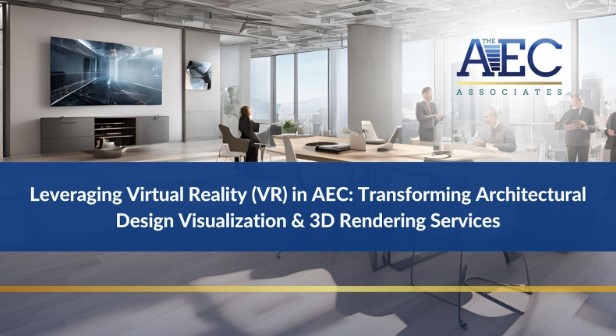Virtual Reality (VR) technology has revolutionized various industries, from gaming to healthcare, by providing immersive and interactive experiences. In the Architecture, Engineering, and Construction (AEC) industry, VR is emerging as a game-changing tool that modernizes traditional practices. By offering an immersive, interactive, and highly detailed view of designs, VR is transforming how architects, engineers, and constructors approach their projects and how they engage with clients through Architectural Design Visualization & 3D Rendering Services.
What is VR in AEC?
VR technology in the AEC industry involves creating a fully immersive, computer-generated environment that users can interact with and explore as if they were physically present. This technology leverages advanced graphics, motion sensors, and sometimes haptic feedback to create realistic and dynamic representations of architectural and engineering designs.
Types of VR Tools and Software Used in the AEC Industry
Several VR tools and software are tailored for the AEC industry, each providing unique features to enhance design and visualization. Popular VR tools include Autodesk Revit, SketchUp with VR plugins, Unity, Unreal Engine, and IrisVR Prospect. These tools allow for the creation of detailed 3D models that can be explored in a virtual environment, offering a realistic sense of scale and space.
Benefits of VR in Design
Enhanced Visualization for Designers and Clients
One of the primary benefits of VR in the AEC industry is enhanced visualization. Traditional 2D drawings and even 3D models on screens can sometimes fail to convey the full scope and scale of a design. VR allows both designers and clients to step inside the design and experience it in a way that is far more intuitive and impactful.
Ability to Experience and Modify Designs Before Construction
VR enables stakeholders to experience a building or space before it is constructed, identifying potential issues and making necessary modifications early in the design process. This proactive approach can prevent costly changes during construction and ensures that the final product meets the client's expectations.
Improved Accuracy and Detail in Design Presentations
Using VR for design presentations significantly improves the accuracy and detail that can be communicated. Designers can present their ideas with a level of clarity and precision that traditional methods cannot match. Clients can explore every nook and cranny of a proposed design, providing detailed feedback that can be incorporated quickly.
VR for Client Presentations
How VR Creates Immersive Experiences for Clients
VR creates highly immersive experiences that allow clients to walk through their future spaces, experiencing the design as if it were already built. This immersion helps clients understand the spatial relationships, materials, and overall feel of the design in a way that static images or videos cannot achieve.
Case Studies of VR Presentations
Several projects have demonstrated the effectiveness of VR in enhancing client understanding and satisfaction. For instance, a leading architectural firm used VR to present a new office building design to their client. The client could virtually walk through the space, which led to productive discussions about layout changes and design features. This interactive session not only impressed the client but also resulted in a final design that closely matched their vision.
Another case involved a residential development where potential buyers could tour their future homes through VR. This immersive experience helped increase pre-construction sales, as buyers could visualize living in the space, making informed decisions quickly.
Implementation in Workflow
Steps to Integrate VR into Existing AEC Workflows
Integrating VR into existing AEC workflows involves several steps:
Selecting the Right VR Tools: Choose VR tools and software that are compatible with your existing design processes and software.
Training and Skill Development: Invest in training for your team to ensure they can effectively use VR technology.
Pilot Projects: Start with pilot projects to test the integration of VR and refine your processes.
Client Engagement: Use VR in client meetings to demonstrate its value and gather feedback.
Iterative Design: Incorporate VR into the iterative design process, using it for regular design reviews and client presentations.
Challenges and Solutions in Adopting VR Technology
Adopting VR technology comes with challenges, such as the initial cost of VR hardware and software, and the learning curve associated with new tools. However, these challenges can be mitigated through careful planning and investment in training. The long-term benefits, such as reduced design errors and improved client satisfaction, outweigh the initial costs.
Future of VR in AEC
Trends and Future Developments in VR for the AEC Industry
The future of VR in the AEC industry looks promising, with ongoing advancements in VR technology and software. Trends such as the integration of VR with Building Information Modeling (BIM) services, the use of VR for remote collaboration, and the development of more affordable VR hardware are set to drive further adoption.
Potential Impacts on Project Timelines, Costs, and Client Relationships
As VR becomes more widespread, its impact on project timelines and costs will be significant. Projects can be completed faster with fewer errors, and clients will have a better understanding of the final product, leading to stronger relationships and increased satisfaction.
Conclusion
In summary, VR technology is transforming the AEC industry by enhancing visualization, improving design accuracy, and creating immersive client experiences. As VR continues to evolve, it offers immense potential to streamline workflows, reduce costs, and foster better client relationships. AEC firms should consider integrating VR into their Design Visualization practices to stay competitive and deliver exceptional results.
AEC firms looking to modernize their Architectural Design Visualization & 3D Rendering Services and enhance client engagement should explore the potential of VR technology. By investing in VR tools and training, firms can offer unparalleled design experiences, improve project outcomes, and achieve greater client satisfaction. Embrace VR today and transform the way you design and present your projects.





Comments